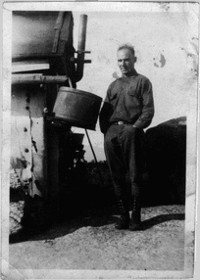|
|
 History of the Fire Observers On Mt Arab
History of the Fire Observers On Mt Arab
The hearty souls who manned the fire observation tower during the over 70 years it was in service were not only required to report forest fires or smoke sightings. They also unofficially provided a vital public service to hikers, educating them on the surrounding area and good conservation practices including forest fire prevention. Each party reaching the summit was given a card, signed by the Observer on duty, to prove that they had climbed the mountain and visited the tower. With the advent of the "Smokey the Bear" campaign to educate the public about forest fire danger and prevention, hikers were given a silver coin featuring Smokey the Bear with the slogan, "Only you can prevent forest fires." During wartime, Observers were required to report any airplanes they saw or heard directly to Military Information Centers. They also participated in any search and rescue operations being conducted in their area. They were required to keep the trail clear and passable and even repaired the telephone line - their only link to their District Ranger who organized fire-fighting crews. The Bell Telephone Company built the telephone line in 1912. It ran from Childwold Station to the top of Mt. Arab.In the early 1940's, radio communications were established between each of the 57 towers located in the Adirondacks. This made the task of pinpointing the location of smoke sightings much quicker, which resulted in more efficient fire fighting efforts. There were several Fire Observers stationed on Arab Mountain (top photo). The first, Jim Barney, was from the Potsdam area. Augustine LaRocque , and then his son, Edgar LaRocque (photo above left), followed. Art O’Connor worked the post during the early 1930's. George "Doc" LaVasseur followed him, both men from Piercefield.. Next was Ansel Dorothy of Childwold, and finally Herman "Woody" Woods from Tupper Lake. "Doc" LaVasseur was stationed on Arab Mountain during the years 1937 through 1964. He was the only Observer to call both the original cabin (built in 1918), and the "new" cabin erected in the early 1950's "home." Prior to the original cabin being built, Observers stayed in tents erected on th summit. The pay scale during the 1930's was $50-$60 per month, with an extra $12 if the Observer stayed in the cabin. The Observers worked from May to November, and protected an area of approximately 625 square miles. During the years 1944-1949, there were over 21 fires reported from Mt. Arab. In the 1950's, "Doc" reported over 30 fires, any of which gone undetected had the potential to equal the devastation of the earlier fires. Also during this time, "Doc" welcomed over 10,800 visitors to the mountain facility. In 1952, the number of visitors rose to over 1,100 per year. In 1998, over 2,200 people visited Mt. Arab in a three-month period. In the early 1980's, New York State determined that the fire observation towers no longer served a vital role in protecting our region from fire and they were closed. Most were either taken down or left to decay where they stood. Arial observations are now conducted. The Friends of Mt. Arab, Inc. appreciate your efforts in support of the restoration of the Mt. Arab site to its former glorious state and are committed to ensuring that it will remain this way to be enjoyed forever. The name Mt. Arab is believed to have been a result of inaccurate translation of the French word, 'érable', meaning Maple (Mountain). 
Edgar LaRocque, An early 20th century Mt Arab Observer (text and pictures from website by Jon Kopp) May 2022 issue of the Adirondack Almanack where you will find another Arab Mountain history by John Sasso RETURN to the FOMA website using the BACK ARROW |
|
|